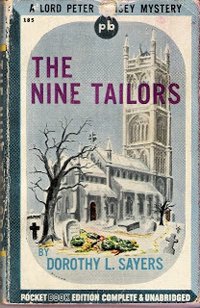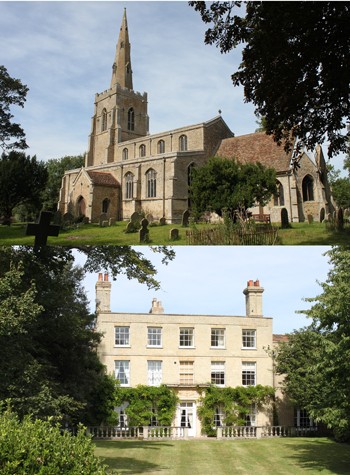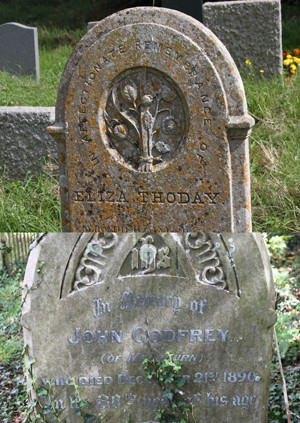Dorothy L Sayers was one of the greats of The Golden Age of crime fiction. Her two most celebrated characters, Lord Peter Wimsey and Harriet Vane, inhabit an England that is long dead, and exist in a society whose values, dress and language are museum pieces. But the landscape which inspired what many believe to be her finest and most influential novel – The Nine Tailors – is largely unchanged. Geographically the Fens are situated mostly in the English county of Cambridgeshire. The region is known for its tranquil beauty, but with moody weather and sometimes peculiar inhabitants, it can be a treacherous environment where a watery end is always a possibility. A great setting for a crime novel…
Fenland history
Until the 17th century, Fenland was largely a swamp – a huge expanse of reeds and shallow, freshwater lakes. That distinction is important, but often missed. Nearer to the coast, the flatlands seem identical, but these were salt water marshes. Inspired by Dutch and Flemish engineers, landowners began to drain the Fens. Ditches were dug, meres were pumped dry, first by windmills and later using steam pumps. By the late 19th century the landscape had been transformed. Arrow straight drains intersected vast fields of black, peaty soil – the most fertile in England. Roads hugged the drain sides, and steam pumps tamed the tides. There were ancient settlements based on sites that earlier drainers – Romans and Saxons – had wrung from the watery expanse. Sheep and cattle grazed on the hard won grassland, and medieval Christians raised towering churches to thank their God for his benevolence.
It is in a wintry Fenland that we encounter Lord Peter Wimsey and his unflappable manservant, Bunter, in the memorable opening to The Nine Tailors. They have driven their car into a ditch. ‘Right and left, before and behind, the fen lay shrouded. It was past four o’clock, and New Year’s Eve; the snow that had fallen all day gave back a glimmering greyness to a sky like lead.’
Wimsey and his man trudge towards the nearest village. ‘They wrapped their coats about them and turned their faces to the wind and snow. To their left the drain straight as a rule could make it, black and sullen, with a steep bank shelving down to its slow, unforgiving waters.’
Brooding prose
Dorothy L Sayers, the author of this brooding prose, was born in Oxford. However, she grew up in Bluntisham, which has been in both Huntingdonshire and Cambridgeshire, dependent on local government boundary changes, but is right on edge of the Fens. Her father was the Rector, so from an early age she was steeped in the lore of ancient buildings, churchyards and bells.
From 1917 to 1928, Sayers’ father ministered at Christchurch, a tiny Fenland village with a Victorian church. Co-incidentally, this is also hinted at in Jim Kelly’s most recent novel, The Funeral Owl. The clear and present danger to people living in Fenland is the power of water and the tides. Though many miles inland, the Fens are kept dry and habitable by a series of sluices and floodgates which, should they fail in the teeth of a spring tide, would return the Fens to their medieval state overnight.
The terrifying final scenes of The Nine Tailors are a graphic portrayal of the flooding caused by a breach in the defences. ‘The waters swelled relentlessly from the breach of Van Leyden’s Sluice and stood level with the top of the Thirty Foot Bank,’ Sayers wrote. ‘Outward and eastward the gold cock on the weather vane stared and strained, fronting the danger, held to his watch by the relentless pressure of the wind from The Wash. Somewhere amid that still surge of water, the broken bodies of Will Thoday and his mate drifted and tumbled with the wreckage of farm and field. The Fen had claimed its own.’
Real and fictional places
It is worth comparing Sayers’ Fenland to Thomas Hardy’s Wessex. Hardy included a map of his Wessex as a frontispiece to every novel. In the main he keeps actual towns and cities in their real position, but renames them – Dorchester becomes Casterbridge and Weymouth becomes Budmouth. Sayers works slightly differently. Her Fenland features everything the actual Fenland does. It has drainage rivers named after their width such as The Thirty Foot, back roads called Droves, and clusters of villages with the same name, but modified by the patron saints of their respective churches. Just as she gives us Fenchurch St Paul and Fenchurch St Peter, in real life we have Terrington St Clement, Terrington St John, Wiggenhall St Peter and Wiggenhall St Mary. Sayers takes all the familiar topographical features of the Fens and rearranges them into an authentic but original pattern.
She also teases us with her place names. When we think we have matched Van Leyden’s Sluice with Denver, she confounds us by mentioning that Denver Sluice is much bigger. When you feel certain that Leamholt must be one of the bigger towns such as King’s Lynn, she introduces the actual King’s Lynn in a passing reference. So, the enthusiastic literary traveler will find it hard to trace Wimsey’s footsteps in any meaningful way.
She does have more fun with some of the surnames of the characters, however. Gotobed is quite a common name in the area, and indeed there used to be a certain Mr Gotobed who, improbable though it sounds, lived in Great Snoring! Thoday and Hinkins are still well represented in old local directories, and Wilderspin is a distinctive name still found in the area around Cambridge. Several of the surnames in The Nine Tailors can be found on headstones in Bluntisham churchyard.
Sayers teases us with the inspiration for St Paul’s church. Many have pinned it down to St Peter’s Church, Upwell. This is indeed a beautiful church, with many fine features, but even its greatest admirers would be pushed to say that it dominates the landscape in the same way that the fictional church does. For that, we have to go a little further north to the church of St Clement, Terrington St Clement, which is on record as having sheltered villagers in times of flood, and for sheer grandeur, there must be elements of St Peter’s at Walpole St Peter in Sayers’ mix. In truth then, she has taken several fine churches and put them together to make the wonderful building which so dominates The Nine Tailors.
Other writers who have taken their inspiration from the Fenland landscape and its reclusive and brooding people include the aforementioned Jim Kelly with his Philip Dryden novels (appraised here) and the award winning novel by Graham Swift, Waterland. Sayers never revisited Fenland with the same intensity she showed in The Nine Tailors, but why would she? No novel in the English language has, before or since, has given us a more frightening and vivid portrayal of the dark and menacing power which lies beneath the apparently bland landscape.
For more on Dorothy L Sayers, read our piece selecting five of her best works, here.
















The 1974 BBC film is the best adaptation of a novel, and the best teleplay, that I have ever seen. I read the book long ago, and just watched the film again. Nothing better.
I agree fully about the 1974 “Nine Tailors.” Great actors, from Ian Carmichael to all of those portraying the smaller roles. And great scenery and dialog. It does justice to the book, beautifully.
I agree, and we love it, the Movie from BBC, from VHS
already transferred to DVD. One of the best movies .
we have been in March an in the fens and we hope,
we see it again. Part 3+4 we will see tonight.
from Frankfurt a.M.